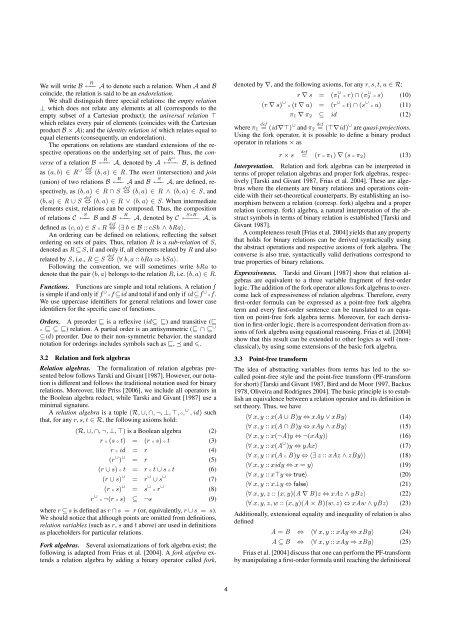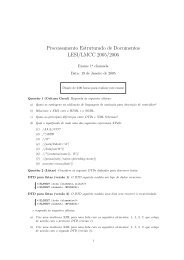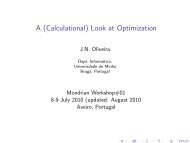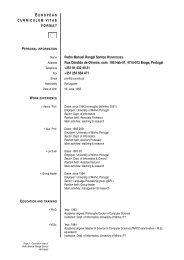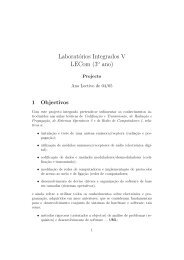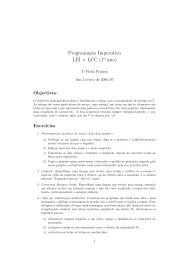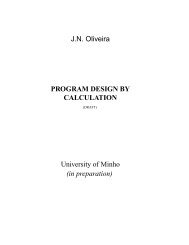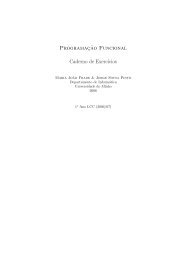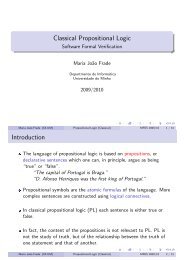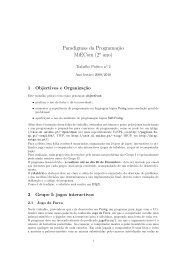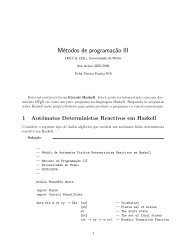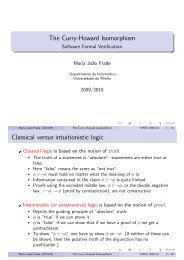Galois
Galois
Galois
You also want an ePaper? Increase the reach of your titles
YUMPU automatically turns print PDFs into web optimized ePapers that Google loves.
We will write B ←−− R<br />
A to denote such a relation. When A and B<br />
coincide, the relation is said to be an endorelation.<br />
We shall distinguish three special relations: the empty relation<br />
⊥ which does not relate any elements at all (corresponds to the<br />
empty subset of a Cartesian product); the universal relation ⊤<br />
which relates every pair of elements (coincides with the Cartesian<br />
product B × A); and the identity relation id which relates equal to<br />
equal elements (consequently, an endorelation).<br />
The operations on relations are standard extensions of the respective<br />
operations on the underlying set of pairs. Thus, the converse<br />
of a relation B ←−− R<br />
A, denoted by A ←−−− R∪<br />
B, is defined<br />
as (a, b) ∈ R ∪ def<br />
⇔ (b, a) ∈ R. The meet (intersection) and join<br />
(union) of two relations B ←−− R<br />
A and B ←−− S<br />
A, are defined, respectively,<br />
as (b, a) ∈ R ∩ S def<br />
⇔ (b, a) ∈ R ∧ (b, a) ∈ S, and<br />
(b, a) ∈ R ∪ S def<br />
⇔ (b, a) ∈ R ∨ (b, a) ∈ S. When intermediate<br />
elements exist, relations can be composed. Thus, the composition<br />
S<br />
of relations C ←−− B and B ←−− R<br />
S◦R<br />
A, denoted by C ←−−− A, is<br />
defined as (c, a) ∈ S ◦ R def<br />
⇔ 〈∃ b ∈ B :: cSb ∧ bRa〉.<br />
An ordering can be defined on relations, reflecting the subset<br />
ordering on sets of pairs. Thus, relation R is a sub-relation of S,<br />
denoted as R ⊆ S, if and only if, all elements related by R and also<br />
related by S, i.e., R ⊆ S def<br />
⇔ 〈∀ b, a :: bRa ⇒ bSa〉.<br />
Following the convention, we will sometimes write bRa to<br />
denote that the pair (b, a) belongs to the relation R, i.e. (b, a) ∈ R.<br />
Functions. Functions are simple and total relations. A relation f<br />
is simple if and only if f ∪ ◦f ⊆id and total if and only if id ⊆f ∪ ◦f.<br />
We use uppercase identifiers for general relations and lower case<br />
identifiers for the specific case of functions.<br />
Orders. A preorder ⊑ is a reflexive (id⊆ ⊑) and transitive (⊑<br />
◦ ⊑ ⊆ ⊑) relation. A partial order is an antisymmetric (⊑ ∩ ⊑ ∪<br />
⊆id) preorder. Due to their non-symmetric behavior, the standard<br />
notation for orderings includes symbols such as ⊑, ≼ and .<br />
3.2 Relation and fork algebras<br />
Relation algebras. The formalization of relation algebras presented<br />
below follows Tarski and Givant [1987]. However, our notation<br />
is different and follows the traditional notation used for binary<br />
relations. Moreover, like Priss [2006], we include all operators in<br />
the Boolean algebra reduct, while Tarski and Givant [1987] use a<br />
minimal signature.<br />
A relation algebra is a tuple (R, ∪, ∩, ¬, ⊥, ⊤, ◦, ∪ , id) such<br />
that, for any r, s, t ∈ R, the following axioms hold:<br />
(R, ∪, ∩, ¬, ⊥, ⊤) is a Boolean algebra (2)<br />
r ◦ (s ◦ t) = (r ◦ s) ◦ t (3)<br />
r ◦ id = r (4)<br />
(r ∪ ) ∪ = r (5)<br />
(r ∪ s) ◦ t = r ◦ t ∪ s ◦ t (6)<br />
(r ∪ s) ∪ = r ∪ ∪ s ∪ (7)<br />
(r ◦ s) ∪ = s ∪ ◦ r ∪ (8)<br />
r ∪ ◦ ¬(r ◦ s) ⊆ ¬s (9)<br />
where r ⊆ s is defined as r ∩ s = r (or, equivalently, r ∪ s = s).<br />
We should notice that although points are omitted from definitions,<br />
relation variables (such as r, s and t above) are used in definitions<br />
as placeholders for particular relations.<br />
Fork algebras. Several axiomatizations of fork algebra exist; the<br />
following is adapted from Frias et al. [2004]. A fork algebra extends<br />
a relation algebra by adding a binary operator called fork,<br />
denoted by ∇, and the following axioms, for any r, s, t, u ∈ R:<br />
r ∇ s = (π1 ∪ ◦ r) ∩ (π∪ 2 ◦ s) (10)<br />
(r ∇ s) ∪ ◦ (t ∇ u) = (r ∪ ◦ t) ∩ (s ∪ ◦ u) (11)<br />
π 1 ∇ π 2 ⊆ id (12)<br />
def<br />
where π 1 = (id ∇⊤) ∪ def<br />
and π 2 = (⊤∇id) ∪ are quasi-projections.<br />
Using the fork operator, it is possible to define a binary product<br />
operator in relations × as<br />
r × s<br />
def<br />
= (r ◦ π 1) ∇ (s ◦ π 2) (13)<br />
Interpretation. Relation and fork algebras can be interpreted in<br />
terms of proper relation algebras and proper fork algebras, respectively<br />
[Tarski and Givant 1987, Frias et al. 2004]. These are algebras<br />
where the elements are binary relations and operations coincide<br />
with their set-theoretical counterparts. By establishing an isomorphism<br />
between a relation (corresp. fork) algebra and a proper<br />
relation (corresp. fork) algebra, a natural interpretation of the abstract<br />
symbols in terms of binary relation is established [Tarski and<br />
Givant 1987].<br />
A completeness result [Frias et al. 2004] yields that any property<br />
that holds for binary relations can be derived syntactically using<br />
the abstract operations and respective axioms of fork algebra. The<br />
converse is also true, syntactically valid derivations correspond to<br />
true properties of binary relations.<br />
Expressiveness. Tarski and Givant [1987] show that relation algebras<br />
are equivalent to a three variable fragment of first-order<br />
logic. The addition of the fork operator allows fork algebras to overcome<br />
lack of expressiveness of relation algebras. Therefore, every<br />
first-order formula can be expressed as a point-free fork algebra<br />
term and every first-order sentence can be translated to an equation<br />
on point-free fork algebra terms. Moreover, for each derivation<br />
in first-order logic, there is a correspondent derivation from axioms<br />
of fork algebra using equational reasoning. Frias et al. [2004]<br />
show that this result can be extended to other logics as well (nonclassical),<br />
by using some extensions of the basic fork algebra.<br />
3.3 Point-free transform<br />
The idea of abstracting variables from terms has led to the socalled<br />
point-free style and the point-free transform (PF-transform<br />
for short) [Tarski and Givant 1987, Bird and de Moor 1997, Backus<br />
1978, Oliveira and Rodrigues 2004]. The basic principle is to establish<br />
an equivalence between a relation operator and its definition in<br />
set theory. Thus, we have<br />
〈∀ x, y :: x(A ∪ B)y ⇔ xAy ∨ xBy〉 (14)<br />
〈∀ x, y :: x(A ∩ B)y ⇔ xAy ∧ xBy〉 (15)<br />
〈∀ x, y :: x(¬A)y ⇔ ¬(xAy)〉 (16)<br />
〈∀ x, y :: x(A ∪ )y ⇔ yAx〉 (17)<br />
〈∀ x, y :: x(A ◦ B)y ⇔ 〈∃ z :: xAz ∧ zBy〉〉 (18)<br />
〈∀ x, y :: xidy ⇔ x = y〉 (19)<br />
〈∀ x, y :: x⊤y ⇔ true〉 (20)<br />
〈∀ x, y :: x⊥y ⇔ false〉 (21)<br />
〈∀ x, y, z :: (x, y)(A ∇ B)z ⇔ xAz ∧ yBz〉 (22)<br />
〈∀ x, y, z, w :: (x, y)(A × B)(w, z) ⇔ xAw ∧ yBz〉 (23)<br />
Additionally, extensional equality and inequality of relation is also<br />
defined<br />
A = B ⇔ 〈∀ x, y :: xAy ⇔ xBy〉 (24)<br />
A ⊆ B ⇔ 〈∀ x, y :: xAy ⇒ xBy〉 (25)<br />
Frias et al. [2004] discuss that one can perform the PF-transform<br />
by manipulating a first-order formula until reaching the definitional<br />
4


